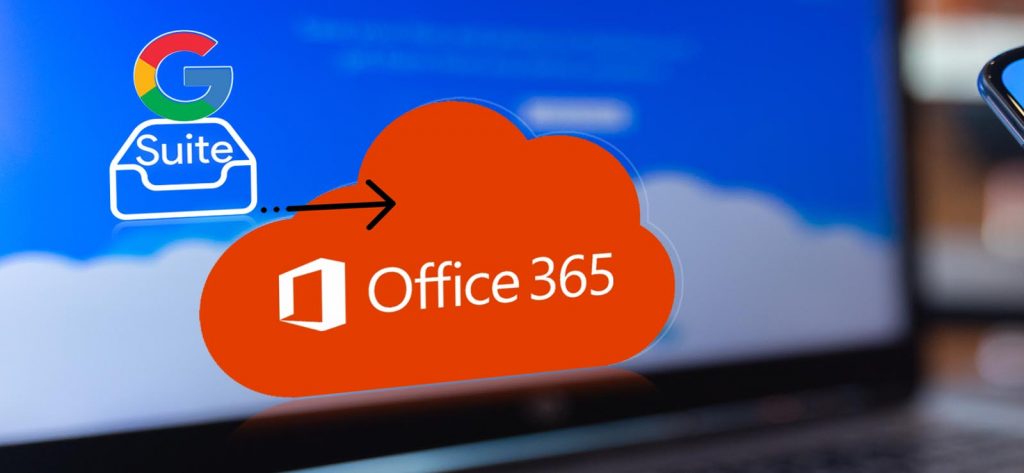Read time 8 minutes
The migration process between different cloud platforms largely depends on the type of email server you’re using and the one you want to migrate to. Many cloud platforms, including Microsoft 365, allow for the import of mailboxes from other platforms. In Microsoft 365, a Super Administrator can use the Microsoft 365 Admin Center to import mailbox emails from G Suite (Google Workspace). Since G Suite supports the IMAP protocol for its emails, manual migration is possible.
The migration process is completed in several stages, during which the mailboxes are prepared and migrated to Office 365. Let’s explore these stages one by one:
Stage 1. Verify the Domain
Before initiating the migration process, it’s crucial to verify to Office 365 that you own the Google Workspace domain. The setup wizard will provide you with a TXT record, which needs to be added at your domain host provider. In the Microsoft Office 365 Admin Center, you can choose from two options to verify the domain ownership.
- When the DNS host provider is Google, then you can add your TXT record here.
- If you had purchased the domain from a third-party domain registrar, then you can contact them to add the TXT record.
After successfully verifying the domain of your Google Workspace accounts, the next step is to create new user accounts in Office 365. You have the option to create users one at a time or in bulk. Each user account should have a mail-enabled mailbox that will receive the data from the Google Workspace users, and the user should be assigned an active license for an Office 365 subscription plan.
Creating a migration file for the G Suite mailboxes is essential to initiate the migration process. This migration file typically contains the details of the G Suite mailboxes you intend to migrate. One convenient way to generate this migration file is by using an MS Excel spreadsheet.
- You should know the app password of the G Suite mailboxes.
- In the case of no app password, the administrator can create a temporary password by resetting the password.
- The size of the migration file should be up to 10 MB only.
Here are the steps that you need to follow opening an Excel file –
- Use the format correctly, without any spaces.
- EmailAddress in A1.
- UserName in B1.
- Password in C1.
- Input the Email Address, Username, and Password in the cells below these entries. Copy these details from the G Suite Admin Console, where all the accounts are listed.
- After inputting the details of G Suite accounts, save the file in CSV format.
To connect the Office 365 account with G Suite, you can create an endpoint at the Microsoft 365 Admin Center.
- In Office 365 admin center, go to Exchange.
- Go to Admin Center and follow recipients >> migration >> more(…) >> Migration endpoints.
- Click the + (New) icon.
- Select IMAP as the migration endpoint type.
- On the new IMAP migration configuration page, input imap.gmail.com as the IMAP Server and keep the other settings as such.
- Enter a new name to the Migration endpoint and leave the rest of the boxes blank. Click new.
- A new migration endpoint is created. Click OK.
The migration from G Suite to Office 365 can be carried out using migration batches that you create within the Admin Center. These migration batches include the migration file you generated for the G Suite mailboxes, which helps facilitate the migration process.
- Go to Exchange in the Office 365 Admin Center.
- Choose recipients, then migration.
- Click New, then select Migrate to Exchange Online.
- Select IMAP migration, then click Next.
- The new page is Select the users page, where you need to click the Browse button to add the migration file.
- In the new migration batch page, choose imap.gmail.com and leave the rest of the settings. Then click Next.
- The default name of the migration batch will be the same as the CSV file that you selected. Click Next.
- Choose the account that will receive the notification after the completion of the migration. Also, choose the time that when you want to start the migration. Then click new.
- A new migration batch has started, and its status as syncing.
Conclusion
TThe manual migration process to move a G Suite account to Office 365 can be quite lengthy and involves several steps. First, the user needs to create a comma-separated value (CSV) file with the necessary migration details. Then, they must set up a migration endpoint within the Office 365 Admin Center and proceed to create a migration job using the defined migration endpoint. This process can be complex and time-consuming, requiring technical expertise to execute successfully.
The manual migration process has limitations as it can only migrate emails from a Gmail account and cannot transfer contacts, documents, and other essential data. For a comprehensive migration when moving from G Suite to Office 365, it’s recommended to use professional software like Kernel G Suite to Office 365. This software can migrate data from all applications and offers various filtering options, simplifying the migration process.
